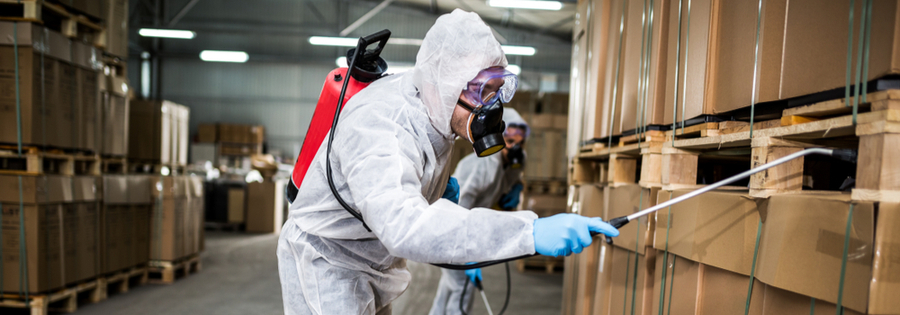A Comprehensive Guide to the Different Sorts Of Bug Control Methods
With the myriad of insect control methods available, it can be overwhelming to find the most efficient remedy for a certain parasite issue. In this thorough overview, we will discover these various types of insect control methods, offering insights right into their applications and benefits. By the end, you will certainly have a clearer understanding of which technique might be the best fit for your insect control demands.
Chemical Pest Control Methods

One usual type of chemical bug control is insecticides. Pesticides are chemical compounds that are specifically developed to kill or ward off pests. They can be used in numerous kinds, such as sprays, lures, or dusts. Pesticides target specific insects, such as mosquitoes, termites, or ants, and can be made use of both inside and outdoors.
One more kind of chemical insect control is rodenticides. These are chemical materials developed to manage populaces of rodents, such as rats and mice.
Herbicide, likewise known as herbicides, are an additional kind of chemical pest control method. Herbicides are created to precisely eliminate unwanted plants, called weeds, without causing damage to desirable plants. They are generally made use of in agriculture, landscape design, and horticulture to regulate the development of unwanted plant life.
While chemical parasite control approaches can be very reliable in eliminating insects, it is essential to use them carefully and adhere to safety standards. Overuse or abuse of chemical pesticides can have negative influence on human health and wellness and the atmosphere. It is crucial to use these approaches properly and take into consideration alternate pest control strategies whenever possible.
Biological Pest Control Approaches
Organic insect control techniques include using living microorganisms or natural materials to take care of and control pest populaces. Unlike chemical approaches, which usually count on artificial chemicals, organic control approaches utilize the natural enemies of bugs to regulate their populaces. This strategy is considered even more eco-friendly and lasting, as it lowers the use of damaging chemicals and reduces the risk of chemical resistance.
One commonly made use of biological bug control technique is the introduction of natural predators or bloodsuckers. Ladybugs are introduced to regulate aphids, while certain wasp species are released to target caterpillars. These predators and parasites prey on insects, lowering their numbers and avoiding problems.
An additional organic control method is making use of microorganisms. Certain bacteria, infections, and fungi can be employed to contaminate and eliminate specific insects. As an example, the germs Bacillus thuringiensis is frequently used to regulate caterpillars, as it creates contaminants that are dangerous to these pests.
Biological control methods can likewise include the usage of pheromones or natural materials that interfere with the breeding patterns of pests. By disrupting their reproduction, these approaches aid to reduce pest populations over time.
While organic pest control approaches are generally reliable, they might need longer durations to achieve wanted results contrasted to chemical approaches. Additionally, cautious factor to consider must be offered to the selection and release of natural adversaries to stop unplanned injury to advantageous microorganisms or environments.
Physical Insect Control Methods
To properly manage and regulate pest populaces, alternate pest control techniques referred to as physical pest control approaches are used. These approaches involve using physical barriers, catches, or gadgets to stop parasites from accessing or damaging residential or commercial property. One common physical bug control technique is making use of displays or internet to maintain pests out of buildings or yards. These screens are usually constructed from great mesh material that permits ventilation while protecting against insects from entering. One more physical bug control method is the installment of fences or walls to keep bigger parasites, such as deer or bunnies, out of gardens or farming areas. These barriers physically block the pests' accessibility to the area, decreasing the possibility for damages. In addition, traps and gadgets can be used to catch or ward off pests. Sticky traps can be positioned in areas where pests are an issue, and the bugs end up being stuck to the adhesive surface. Ultrasonic devices can likewise be used to discharge high-frequency audios that are undesirable to parasites, triggering them to leave the area. Physical pest control techniques are an environmentally friendly choice to chemical pesticides, as they do not count on the usage of dangerous chemicals.
Natural Parasite Control Techniques
All-natural insect control methods supply a sustainable and environmentally friendly technique to handling and eliminating insects. These approaches focus on making use of all-natural compounds and organic representatives, reducing the requirement for chemical pesticides that can hurt the atmosphere and human wellness. One of one of the most typical all-natural parasite control methods is organic control. This involves introducing all-natural predators or parasites to victimize or parasitize the pests. Ladybugs are commonly presented exterminator phone number to yards to control aphid populaces. One more all-natural technique is making use of repellents stemmed from plants. Certain plants, such as marigolds, lavender, and peppermint, produce aromas that fend off parasites like mosquitoes, flies, and ants. Additionally, cultural control techniques can be used to stop and handle parasite invasions. This consists of appropriate cleanliness, routine upkeep, and advertising biodiversity in the yard. As an example, revolving crops, removing garden particles, and encouraging all-natural predators can aid protect against the accumulation of insects. By taking on these natural bug control approaches, people and neighborhoods can effectively manage parasites while reducing the negative effect on the setting and human wellness.
Integrated Parasite Management (IPM)
Integrated Parasite Management (IPM) is an extensive and systematic technique to pest control that incorporates numerous strategies and methods to effectively take care of bugs while minimizing using chemical pesticides. IPM aims to keep insect populaces below the economic injury level by making use of a mix professional rodent control of cultural, organic, and chemical control approaches.
Cultural control methods entail modifying the setting to make it less favorable for bugs. This can consist of practices such as crop turning, proper hygiene, and using immune plant ranges. By developing unfavorable conditions for parasites, cultural control techniques can substantially decrease bug populaces.

Chemical control methods are used as a last option in IPM. They entail the targeted and wise use chemicals to take care of insect populations. Unlike conventional pest control approaches, IPM intends to minimize using chemical pesticides by employing alternate methods.
Integrated Bug Administration (IPM) is a proactive technique that concentrates on lasting parasite management rather than relying solely on reactive measures. By combining multiple control methods, IPM provides a more sustainable and eco-friendly approach to pest control.
Conclusion
To conclude, this post has supplied a detailed introduction of the different pest extermination service kinds of parasite control approaches. It went over chemical, organic, physical, and natural bug control approaches, as well as the integrated insect monitoring approach. By recognizing these various methods, people can make enlightened choices on which pest control approach is most appropriate for their particular demands and preferences. Efficient insect control is essential in keeping a healthy and pest-free environment.